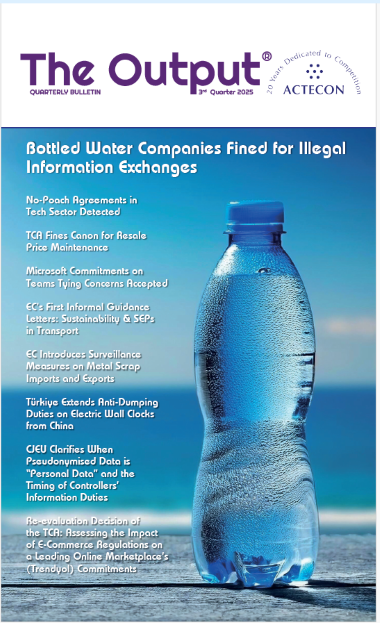Unveiling the Distinction: Turkish Competition Authority Clarified “Mergers” and “Acquisitions” under Turkish Merger Control Regime
| Competition Law

Unveiling the Distinction: Turkish Competition Authority Clarified “Mergers” and “Acquisitions” under Turkish Merger Control Regime
Article by Erdem Aktekin, Helin Yüksel and Mehmet Mikail Demir
Introduction
With its decision dated 17 March 2022 and numbered 22-13/205-88, the Turkish Competition Authority (“TCA”) cleared the transaction concerning the merger of Slim Fusina Rolling S.R.L. (“Slim Fusina”) and Niche Fusina Rolled Products S.R.L. (“NFRP”) (the “Transaction”) on the grounds the Transaction does not significantly impede effective competition. However, with a follow-up submission, the transaction parties argued that the Transaction should have been deemed an “acquisition” and not a “merger” as the TCA categorized it. Accordingly, the parties requested TCA re-evaluate its decision based on Article 11 of Law No. 2577 on Administrative Judicial Procedure.
As a result of its re-evaluation, with its decision dated 27 October 2022 and numbered 22-49/722-302 (the “Decision”), the TCA concluded that the characterization of the Transaction as a “merger” was accurate and therefore, no further action was needed. The Decision sheds light on how the TCA interprets the definitions of “merger” and “acquisition” and is of significance since knowing which transaction will be categorized under which heading is crucial for the notification process.
Background Information on the Transaction
Slim Aluminum S.p.A controlled Slim Fusina solely, while Concord Resources Limited (“CHRL”) and Niche European Holdings LLC (“Niche”) controlled NFRP jointly. The notification form stated that the parties had carried out the Transaction within the scope of the Venice court’s bankruptcy proceedings against Slim Fusina due to the insufficient cash flow, and as a result of the Transaction, all of Slim Fusina’s assets, legal relationships, and liabilities were to be transferred to NFRP. Accordingly, Slim Fusina was to cease its business activities, its legal personality was to expire, and NFRP was to continue as the merged entity.
By considering that Slim Fusina and NFRP would merge under NFRP after the consummation of the Transaction, and the merged entity would continue its activities as a single legal entity, the TCA concluded that the Transaction should be classified as a merger.
Parties Claimed that the Transaction was not a Merger but an Acquisition
Although the TCA had approved the Transaction, the parties argued that the transaction should have been assessed as an acquisition rather than a merger. They applied under Article 11 of Law No. 2577 on Administrative Judicial Procedure for re-evaluation of the decision on the following grounds:
- The notification form defined the transaction as an acquisition of joint control of the business unit of Slim Fusina by CRHL and Niche; NFRP was a special purpose vehicle jointly controlled by CRHL and Niche.
- As NFRP was a special purpose vehicle established to carry out the Transaction and did not engage in any commercial activity or generate turnover, it should not have been deemed an “undertaking concerned.” The Guidelines on Undertakings Concerned, Turnover, and Ancillary Restraints in Mergers and Acquisitions stipulates that “in case the joint venture is used as an instrument in an acquisition by the parent companies, for instance, if the joint venture is established only for the acquisition, is not a full-function joint venture and does not start operating yet, the parent companies are considered as the undertakings concerned, not the joint venture.”[1]
- The undertakings concerned within the scope of the Transaction were CRHL and Niche, the parent undertakings of NFRP. Ultimately, CRHL and Niche acquired joint control over Slim Fusina through NFRP. Thus, NFRP should not have been considered the direct or ultimate party of the Transaction.
In light of the foregoing, the parties requested the Transaction to be considered an acquisition, rather than a merger.
Re-evaluation by the TCA
After determining that the parties had fulfilled the required procedural steps for applying under Article 11 of Law No. 2577 on Administrative Judicial Procedure, the TCA proceeded with its assessment of the substance of the application.
The TCA’s decision refers mostly to the provisions of Communiqué No. 2010/4 on Mergers and Acquisitions Requiring the Approval of the Competition Board (“Communiqué No. 2010/4”) and Guidelines on Cases Considered as a Merger or an Acquisition and the Concept of Control (“Control Guidelines”) as expected.
TCA indicated that according to the Control Guidelines, “A merger within the scope of Article 7 of the Act occurs when two or more independent undertakings amalgamate into a new undertaking by terminating their legal entities. A merger within the scope of the Act may also occur where an undertaking is included in its entirety under the body of another undertaking in which case the legal personality of one undertaking is terminated whereas the other’s legal personality is kept.”[2]
Furthermore, the Control Guidelines state that “A merger within the meaning of article 7 of the Act may also occur where the combining of the activities of previously independent undertakings results in the creation of a single economic unit although the undertakings do not amalgamate into a single legal entity. This is the case, for instance, where two or more undertakings, while retaining their individual legal personalities, establish a common economic management contractually. In other words, a transaction resulting in a de facto amalgamation of the undertakings concerned under a single economic unit is regarded as a merger within the scope of the Act. A prerequisite for the determination of such a de facto merger is the existence of a permanent, single economic management.”
The initial decision shows that during its initial assessment of the notification, the TCA requested information to clarify whether Slim Fusina would (i) be fully included in NFRP or (ii) maintain its legal personality and commercial activities after the consummation of the Transaction. In their responses, the parties confirmed that Slim Fusina’s all assets, rights, and obligations would be transferred to the NFRP and its commercial activities would cease. It was further explained that Slim Fusina would be deregistered from the Trade Registry and its legal personality would be terminated.
Accordingly, the TCA explained that as the merged entity would continue its existence under NFRP, which would be controlled jointly by CRHL and Niche, the Transaction should be categorized as a merger.
The TCA further explained that the parties had stated the following in the notification form:
- Having its own resources: NFRP, as an independent company, has its own resources including assets, employees, revenue, systems, and a separate board of directors and will continue to have those.
- Market position: NFRP is active in the external market with its own suppliers and customers and will fulfil not just one specific function for their parent companies.
- Lasting basis: NFRP’s activities in the market are not limited to a certain period and it operates on a lasting basis.
Against this background, the TCA determined that NFRP (i) was a full-functional joint venture, not a special purpose vehicle established to carry out the Transaction, and (ii) would be active as the merged entity in the market. Thus, the TCA pointed out that the claim of the parties that NFRP, as a special purpose vehicle, could not be considered as an undertaking concerned or merging party. Thus, the Transaction should be classified as an acquisition, directly contradicted by the information provided on the full-functional nature of NFRP provided in the notification form.
In light of the foregoing, the TCA rejected the parties’ application under Article 11 of Law No. 2577 on Administrative Judicial Procedure. The Decision is significant as it provides clarity and guidance on the definitions of fundamental concepts within the Turkish merger control regime.
Published by Concurrences on May 19, 2023







